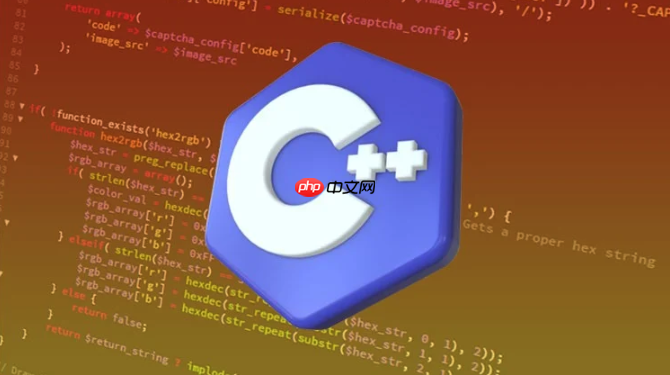答案是实现自定义STL分配器需定义类型别名、rebind结构体及allocate、deallocate、construct、destroy方法,可替换内存管理逻辑如使用内存池,最后将分配器作为模板参数传给容器,注意类型不兼容和线程安全问题。

在C++中实现一个自定义的STL分配器,主要是为了控制容器(如vector、list等)的内存分配行为。比如用于性能优化、内存池管理或调试内存泄漏。STL分配器需要满足特定接口要求,下面介绍具体实现步骤。
STL分配器必须提供一些标准类型和方法。最基本的模板结构如下:
template<typename T>
class MyAllocator {
public:
using value_type = T;
using pointer = T*;
using const_pointer = const T*;
using reference = T&;
using const_reference = const T&;
using size_type = std::size_t;
using difference_type = std::ptrdiff_t;
<pre class='brush:php;toolbar:false;'>// 用于支持不同类型的再绑定
template<typename U>
struct rebind {
using other = MyAllocator<U>;
};
MyAllocator() noexcept {}
template<typename U>
MyAllocator(const MyAllocator<U>&) noexcept {}
~MyAllocator() = default;
// 分配未初始化内存
pointer allocate(size_type n) {
return static_cast<pointer>(::operator new(n * sizeof(T)));
}
// 释放内存
void deallocate(pointer p, size_type) noexcept {
::operator delete(p);
}
// 构造对象
void construct(pointer p, const T& val) {
new(p) T(val);
}
// 析构对象
void destroy(pointer p) {
p->~T();
}};
这个分配器使用全局 ::operator new 和 ::operator delete 进行内存管理,但你可以替换成自己的逻辑,比如内存池。
立即学习“C++免费学习笔记(深入)”;
如果你想用内存池或固定缓冲区,可以在 allocate 和 deallocate 中替换默认行为。例如,使用简单的静态内存池:
template<typename T, size_t N = 1024>
class PoolAllocator {
private:
alignas(T) char pool[N * sizeof(T)];
bool used[N] = {false};
<p>public:
using value_type = T;
template<typename U>
struct rebind {
using other = PoolAllocator<U, N>;
};</p><pre class='brush:php;toolbar:false;'>PoolAllocator() noexcept = default;
template<typename U>
PoolAllocator(const PoolAllocator<U, N>&) noexcept {}
T* allocate(std::size_t n) {
if (n != 1) throw std::bad_alloc();
for (size_t i = 0; i < N; ++i) {
if (!used[i]) {
used[i] = true;
return reinterpret_cast<T*>(pool + i * sizeof(T));
}
}
throw std::bad_alloc();
}
void deallocate(T* p, std::size_t) noexcept {
size_t index = (reinterpret_cast<char*>(p) - pool) / sizeof(T);
if (index < N) used[index] = false;
}
void construct(T* p, const T& val) {
new(p) T(val);
}
void destroy(T* p) {
p->~T();
}};
这个例子限制只能分配单个对象,适合小对象频繁创建销毁的场景。
定义好分配器后,可以将其作为模板参数传给标准容器:
std::vector<int, MyAllocator<int>> vec; vec.push_back(10); vec.push_back(20); <p>// 使用内存池版本 std::vector<double, PoolAllocator<double, 100>> vec2; vec2.push_back(3.14);</p>
注意:分配器是容器类型的一部分,std::vector<int, A1> 和 std::vector<int, A2> 是不同类型,不能直接赋值。
实现自定义分配器时需注意以下几点:
基本上就这些。通过自定义分配器,你可以精细控制内存行为,提升特定场景下的性能或可追踪性。
以上就是c++++怎么实现一个自定义的STL分配器_c++自定义内存分配器的实现步骤的详细内容,更多请关注php中文网其它相关文章!

c++怎么学习?c++怎么入门?c++在哪学?c++怎么学才快?不用担心,这里为大家提供了c++速学教程(入门到精通),有需要的小伙伴保存下载就能学习啦!

Copyright 2014-2025 https://www.php.cn/ All Rights Reserved | php.cn | 湘ICP备2023035733号